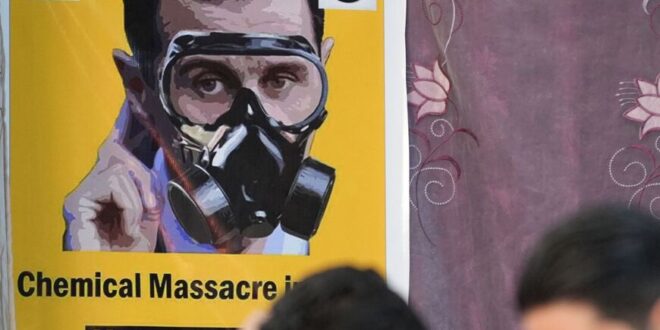Anti-government protests in government-held areas have been driven by a fuel price hike on top of the generally dismal economic situation in war-torn Syria.
Anti-government protests in southern Syria continued on Thursday, the fifth day in a row, with demonstrations spreading to other parts of the country.
In Suwayda, a primarily Druze city in the southwest, hundreds of people gathered to hoist signs and deliver a message to President Bashar al-Assad, at one point chanting, “Syria is ours and it is not for Al-Assad’s family.” The protesters also denounced the deteriorating living conditions in the country and demanded the release of detainees. Some demonstrators additionally blocked several roads in Suwayda and the surrounding areas, reported the UK-based Syrian Observatory for Human Rights.
The local news outlet, Suwayda 24, published a video showing a large crowd of young men chanting, “One, one, one. The Syrian people are one.”
#شاهد: كلمة ولا أروع لأحد شباب عشائر البدو في ساحة السير/الكرامة وسط السويداء الآن، والهتافات تهز الساحة.. pic.twitter.com/EO9GuQx2wR
— السويداء 24 (@suwayda24) August 24, 2023Istanbul-based Syria TV reported that on Wednesday demonstrations had spread to the northwest, to government-controlled parts of Aleppo province. Security forces dispersed protesters in Al-Fardous, a neighborhood of Aleppo city, according to the outlet.
The US-based non-profit Syrian Emergency Task Force reported on Thursday that protests had taken place this week in Daraa, in the south, and Deir ez-Zor, in the east, as well as in Aleppo. The Associated Press reported demonstrations in Daraa on Monday.
The Syrian government has not commented on the apparent unrest. The pro-opposition Shaam News Network reported on Thursday that Suwayda Governor Bassam Parsik had met with the Druze community’s spiritual leader, Hikmet al-Hijri, in response to the protests.
Sweida's governor held discussions with the spiritual leader of the Druze community to tackle the ongoing protests within the city. He was informed that the people's demands are clear and that protests will continue until those demands are fulfilled.https://t.co/fbc1AiRYq4
— Haid Haid (@HaidHaid22) August 24, 2023Why it matters: The protests, which broke out in Suwayda last week, were initially in response to high fuel prices. After almost a decade of civil war, Syria’s economy remains in tatters. Corruption, poor governance, Western sanctions and an earthquake in February have exacerbated Syrians’ economic misery. The sustained protests in Suwayda — the site of anti-government demonstrations in 2020 and 2022 — and the subsequent appearance of demonstrations in other parts of the country point to their picking up momentum.
Recent government actions have heightened discontent among Syrians. Seeking to lower the deficit, the government in Damascus lifted fuel subsidies last week, causing a jump in price.
Joshua Landis, director of the Center for Middle East Studies at the University of Oklahoma, said that Syrians are angry that the living situation has not improved with the decreased fighting in the country in recent years.
“People are desperate,” Landis told Al-Monitor. “There’s no electricity, food prices are outrageously high, salaries are low. It’s a perfect storm. Things have gotten much worse since the end of the fighting, if we can call it that. People were expecting things would get better.”
Syria has largely been reintegrated into the Arab world politically. The Arab League readmitted it in May, and Saudi Arabia, which previously backed Syrian rebel groups against Assad’s government, restored relations the same month. Assad has failed, however, to use these improved relations to benefit the economy, according to Landis.
“The regime has no clue and is mired in corruption,” he said. “Despite rekindled diplomatic relations with Arab countries, there is no foreign investment.”
Suwayda, which remained in government hands throughout the civil war, has traditionally received a degree of support for the Assad government. Protests in government-controlled areas have been relatively rare in recent years. Landis said Druze views toward the Assad government, however, are more motivated by fear of the opposition than support for the former.
“Druze haven’t wanted regime change because the opposition looked a lot worse,” he said, pointing to past Islamic State attacks on Suwayda. The radical Islamists consider Druze to be apostates.
Some of the protests are taking place in areas that attained deep significance during the Syrian civil war. Daraa is widely considered the birthplace of the Syrian uprising due to protests that took place there in 2011. The civil war broke out that year, following the Assad government’s violent crackdown on protests stemming from the Arab Spring, which began in late 2010 in Tunisia and spread across the Middle East. Aleppo was the site of fierce battles between rebel groups and government forces from 2012 to 2016.
Today, Assad’s forces, backed by Russia and Iran, control most of Syria. The remaining rebel groups are mostly confined to the north, and a Kurdish-led administration controls the northeast.
Despite the strengthening protests, Landis said the current situation is different from 2011.
“There is no foreign support for an uprising; there is no potential for unity; the opposition has been destroyed,” he said.
 Eurasia Press & News
Eurasia Press & News



